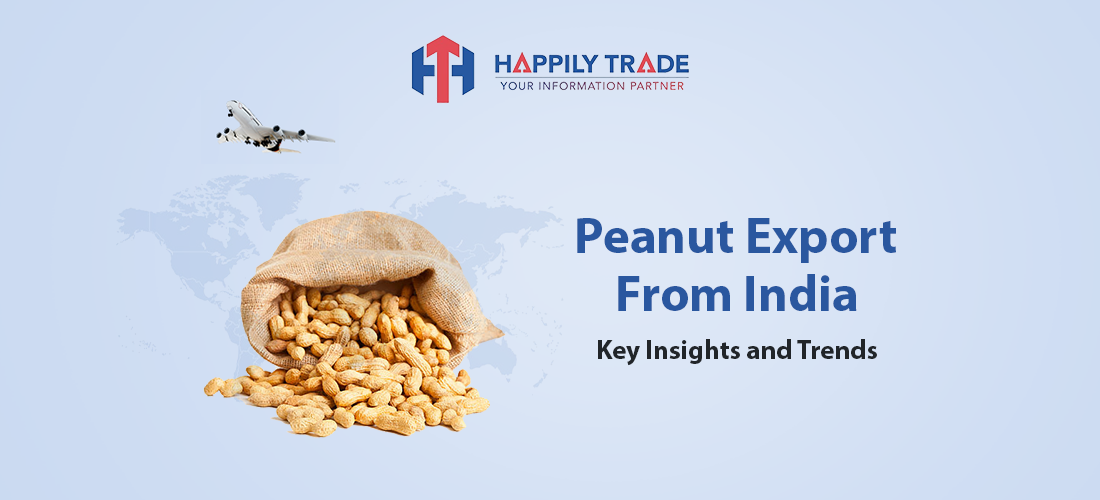Peanut Export From India: Key Insights and Trends
- Log in to post comments
Did you know peanuts are more than just a popular snack? Packed with nutrition, they’re a staple ingredient in cuisines, snacks, and products worldwide. From peanut butter to cooking oils, peanuts fuel industries and diets alike. This humble legume also plays a massive role in global trade, with India as a key contributor to the global peanut market.
As one of the largest exporters of peanuts, India meets the rising global demand with its rich agricultural resources and expertise. Understanding the trends in peanut exports from India isn’t just important for traders—it’s key for anyone looking to tap into this market's vast opportunities. Let’s dive into India’s peanut export story and what drives its success.
Overview of the Peanut Export
The peanut export industry is a significant segment of global agricultural trade, with countries like India, the USA, Argentina, and China being major exporters. Peanuts are in high demand for their nutritional value and versatile uses in food processing, oil extraction, and confectionery. Export trends are influenced by factors such as production quality, international demand, pricing, and trade regulations. With rising global consumption, peanut exports continue to grow, offering lucrative opportunities for producers and traders worldwide.
India’s Role in the Global Peanut Export Market
India has emerged as one of the largest exporters of peanuts globally. The country’s peanut exports contribute to over 18% of the world’s total supply, with an increasing share of the global peanut market. In recent years, Indian peanuts have gained a reputation for quality, especially in key export destinations.
The vast cultivation areas in states like Gujarat, Andhra Pradesh, Tamil Nadu, and Rajasthan have made India the second-largest producer of peanuts worldwide, only behind China. India grows a variety of peanuts, including Bold (Runner), Java (Spanish), and Red Natal peanuts, which cater to diverse global preferences. These varieties are known for their distinct size, flavor, and oil content, making them ideal for multiple uses, from snacks to oil production.
India’s peanut export data reveals that the country exports peanuts in multiple forms—raw, roasted, salted, and as peanut butter or oil. This diversification has helped India cater to international markets, including the Middle East, Europe, and Southeast Asia. As global demand for peanuts continues to rise, India’s strategic positioning and diverse offerings enable it to meet the needs of various international markets effectively.
Factors Driving India's Peanut Exports
Several factors have contributed to the growth of India's peanut exports:
- Favorable Climatic Conditions: India's diverse climate and fertile soil make it ideal for peanut cultivation. India produces around 7-8 million metric tons of peanuts annually.
- Government Support: The Indian government has implemented various policies and initiatives to promote agricultural exports, including peanuts. Government subsidies and export incentives have played a crucial role in boosting India's peanut exports.
- Increasing Global Demand: The rising global demand for healthy and nutritious foods, including peanuts, has boosted India's peanut exports. The global peanut market is estimated to be worth over US$100 billion.
- Competitive Pricing: India's competitive pricing, coupled with its high-quality produce, makes it an attractive supplier for international buyers. India's lower production costs and efficient supply chain give it a price advantage over many competitors.
- Diversification of Product Range: India is not only exporting raw peanuts but also value-added products like peanut butter, peanut oil, and peanut flour. The value-added peanut products segment is growing rapidly, contributing to higher export earnings.
Top Peanut Exporters in India
Some of the leading peanut exporters in India include:
- Agrocrops: Recognized as the number-one peanut exporter in India by the Ministry of Commerce.
- Badani Corporation: A prominent manufacturer, exporter, and supplier of peanuts.
- Dhaval Agri Exports LLP: A leading exporter of high-quality peanuts.
- SKYZ International: A significant exporter of bold and Java peanuts.
- TTT Exports: A renowned exporter of Indian spices, including peanuts.
Key Export Destinations for Indian Peanuts
India exports peanuts to a wide range of countries across the globe. Some of the major export destinations for Indian peanuts include:
India exports peanuts to a wide range of countries across the globe. Some of the major export destinations for Indian peanuts include:
- Indonesia
- Vietnam
- United Arab Emirates
- China
- Bangladesh
- Malaysia
Trends in the Global Peanut Market
The global peanut market has evolved due to changing consumer preferences and market dynamics. Here are some key trends influencing peanut exports and trade:
- Rising Demand for Health Foods: Peanuts have become popular as health-conscious consumers seek plant-based protein sources. Peanuts are rich in protein, healthy fats, and essential vitamins, making them a preferred snack and ingredient in many diets. This shift in consumer behavior has contributed to the rising demand for peanuts, boosting peanut export opportunities from India and other major exporters.
- Technological Advancements in Agriculture: Advancements in agricultural technology, such as improved irrigation techniques, pest control, and soil management, have led to higher peanut yields. These innovations have enabled India to increase its peanut production, meeting the growing global demand while maintaining competitive pricing in the global peanut market.
- Increasing Demand from Emerging Markets: Emerging markets, particularly in Africa and Asia, are experiencing increased demand for peanuts. As urbanization and middle-class growth continue, these regions become key markets for Indian peanut exporters. The rise of the global middle class is expected further to fuel the demand for peanuts and related products, providing new opportunities for Indian peanut export.
- Sustainability Focus: There is an increasing global focus on sustainable and environmentally friendly agricultural practices. As consumers become more aware of the environmental impact of their food choices, sustainable sourcing of peanuts has gained importance. Indian farmers and exporters are increasingly adopting eco-friendly farming practices, which may help meet the sustainability demands of the global peanut market.
The Role of Peanut Export Data
Global export import data is essential for tracking the flow of peanut trade across borders. By analyzing this data, businesses and policymakers can gain insights into supply chain dynamics, monitor demand shifts, and identify emerging markets for peanut exports. It also helps forecast market trends, spot new opportunities, and make informed pricing and export strategy decisions.
Leveraging peanut export data enables businesses to optimize supply chains, minimize risks, and increase profitability. This data helps forecast production and demand, which is key to managing price fluctuations in the global peanut market. Monitoring export data allows exporters to stay competitive and responsive to global market changes.
Challenges in the Peanut Export Industry
While India’s peanut export sector has witnessed steady growth, several challenges remain that could affect future export performance:
- Climate Change: Peanut production depends on weather conditions, and unpredictable weather patterns can impact crop yields. Climate change risks India’s peanut farming industry, potentially reducing production and lowering export volumes.
- Competition from Other Exporters: Other major peanut producers, such as China, Argentina, and the United States, compete in the global peanut export market. As these countries increase their production and improve quality, India’s share of the global peanut market could be affected.
- Trade Barriers and Tariffs: Trade policies, tariffs, and non-tariff barriers imposed by importing countries can also challenge India’s peanut exporters. Rising protectionism and trade restrictions can lead to disruptions in supply chains and reduce the volume of peanuts exported from India.
- Quality Control: Maintaining consistent quality is essential for sustaining long-term export relationships. Indian peanut exporters must comply with stringent food safety standards and ensure that their products meet the quality expectations of international buyers. Any lapse in quality control can harm India’s reputation in the global peanut market.
Frequently Asked Questions
Which countries import the most peanuts from India?
Countries like Vietnam, Indonesia, and the UAE are among the top importers of Indian peanuts due to their quality and competitive pricing.
What is the current demand for peanuts in the global market?
The global demand for peanuts is growing, driven by their use in snacks, oil production, and the rising popularity of plant-based diets.
How can I start exporting peanuts from India?
To export peanuts, you need a valid IEC (Import Export Code), knowledge of international trade regulations, and access to market insights like global export import data.
What makes Indian peanuts competitive in the global market?
Indian peanuts are valued for their quality, consistent supply, and diverse forms like raw, roasted, and peanut butter, catering to global preferences.
What is the export potential of peanuts in 2024?
With increasing global demand and India’s strong production capabilities, peanut exports are expected to grow significantly in 2024.








